Ezekiel 35-48
Introduction
Ezekiel was both a prophet and a priest, and though his book is part of the Major Prophets, no other part of scripture refers to him by name. He is most known for his vision of God, but there is a lot of other important material as well, including end-times events and the Millennial Kingdom. Unlike other prophetic books, this one seems to be largely chronological and includes frequent date markers, a chart of which appears in the commentary under Structure. God refers to Ezekiel as “son of man” (human), and Ezekiel refers to God as “Adonai YHWH” (Lord of Lords). Please refer to these resources as well: this commentary, the NETS Bible, and this LXX Interlinear.
Ezekiel 35-36
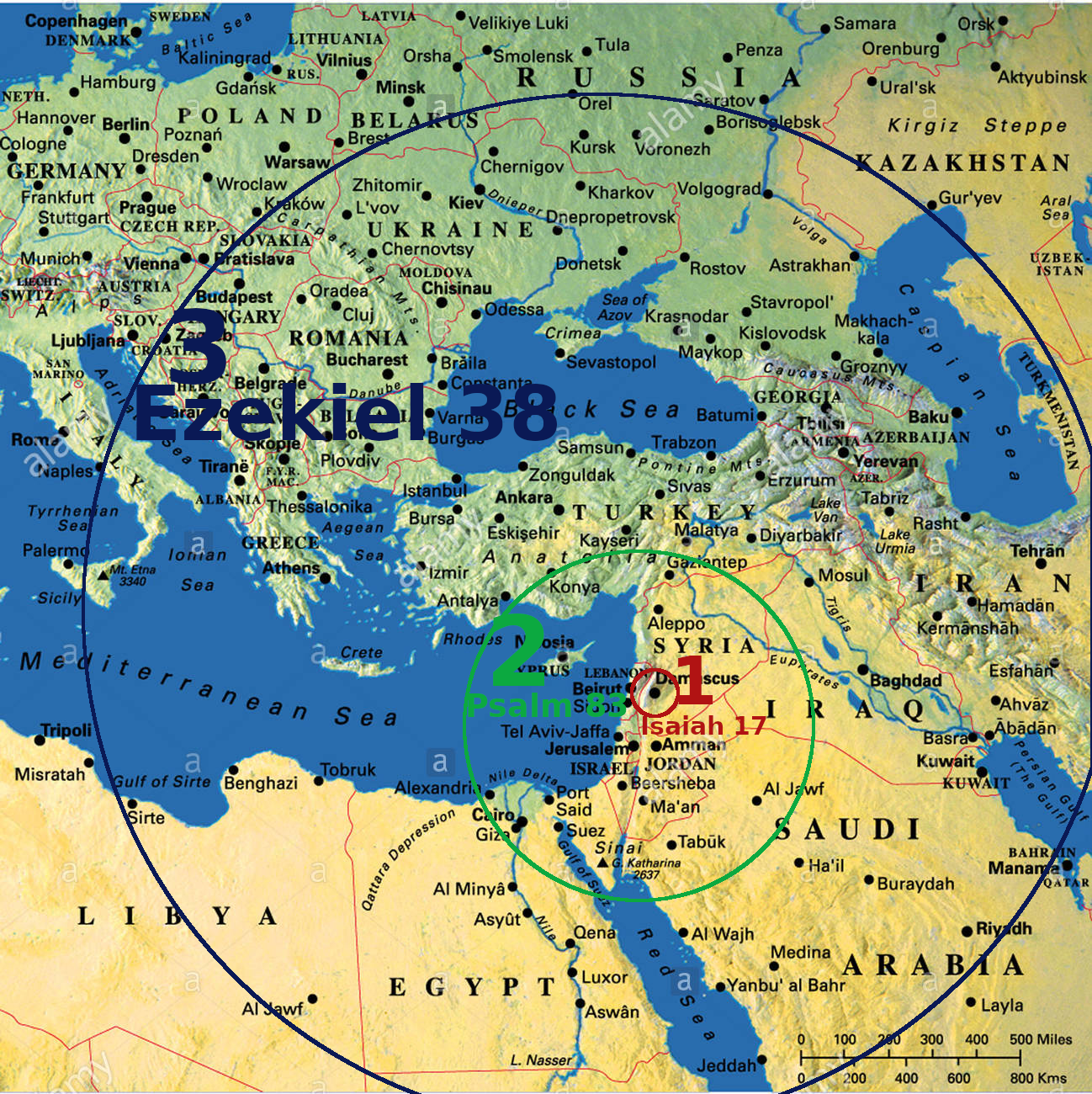 This prophecy against Mt. Seir, representing Edom, is about payback for their gleeful abuse of the people of Israel. It’s never wise to gloat over our enemy’s demise, even if it’s deserved. Then in ch. 36 Then comes one addressed to another mountain or set of them, that being Israel. Though it takes till verse 8 to get to the point, the promise of eventual restoration is given again. But the real point isn’t until verse 22, where God reminds them that this restoration isn’t because of them or their merits, but only because God will preserve his reputation in spite of them. In fact, he goes on to say that they themselves had done everything to ruin it. What do we do today concerning God’s reputation?
This prophecy against Mt. Seir, representing Edom, is about payback for their gleeful abuse of the people of Israel. It’s never wise to gloat over our enemy’s demise, even if it’s deserved. Then in ch. 36 Then comes one addressed to another mountain or set of them, that being Israel. Though it takes till verse 8 to get to the point, the promise of eventual restoration is given again. But the real point isn’t until verse 22, where God reminds them that this restoration isn’t because of them or their merits, but only because God will preserve his reputation in spite of them. In fact, he goes on to say that they themselves had done everything to ruin it. What do we do today concerning God’s reputation?
Mercy, not merit, is often the real reason for our blessings. This is why it’s dangerous to draw a direct cause-and-effect relationship between how life is going and how we behave. Blessings in this life are never guaranteed; it’s the age of faith, not sight. So when people say either “I’m suffering because I don’t go to church”, or “I’m being blessed because I tithe”, they’re saying it depends on our works rather than our standing in Christ. We’re to learn to trust God even when obedience makes life harder, and also to never think that God turns a blind eye to our sin. Focus on the relationship.
Verse 34 leads many to believe that since God is the one to bring Israel back, then the present nation of Israel is illegitimate. But who is any other nation to point fingers? And as we’ll learn while studying prophecy in books such as Daniel, Israel must be in the land in unbelief so their purification as a nation can be completed. Is this not also God’s doing, even if through the plans of the wicked, as he has done many times in Israel’s history?
Another point here is that the heart of flesh replacing the heart of stone is directed at the same nation who has received all the other prophetic messages: the people and land of Israel. Certainly we Christians have received a new heart, but that isn’t the topic here. We know this especially from verse 28, which states it has to do with the land God gave to their ancestors; the Body of Christ has never had a land. And the rest of the description makes it clear why there will be a sacrifical system during the Millennium: It’ll be a reminder of God’s mercy against an undeserving nation, as stated explicitly in verse 32.
Ezekiel 37
Now we come to the meat of Ezekiel’s prophecies of the end times. First is the vision of “the valley of dry bones”. The bones clearly represent the fallen nation of Israel, so the question of whether they could live again is whether Israel would be a nation again, after a very long exile. It seems that seventy years in Babylon would be too short for the bones to become so very dry, but nearly 1900 years from the destruction of the temple to modern Israel would be a better fit. In fact, many non-literal prophetic interpretations grew out of the belief that Israel would never be a physical nation again, yet there they are, in unbelief, as God prophesied.
Notice also that this restoration would come in stages: first the bones being set in order, then the tendons and muscles, then finally life from God. So also would be the restoration of the nation of Israel in the land of Canaan. This is stated explicitly in verse 11, lest anyone try to interpret it as an allegory of personal salvation. Also, the nation in the first century was not ruled over by one king, as specified in verse 22, and it goes on to say that David will rule over this united kingdom of Israel. Though the commentary insists that this must refer to the Messiah, can we switch so quickly from the literal nation of Israel, to David being only a type or figure of the Messiah? He will be resurrected along with all the other righteous people, so why must he be ruled out? Jesus will rule all the nations (Rom. 15:12, Rev. 12:5, 19:15), not just Israel.
Ezekiel 38
Now comes the familiar prophecy against “Gog, of the land of Magog, the chief prince of Meshech and Tubal.” We need to break that down so we’re less likely to misinterpret the rest of the prophecy. The notes in the NET Bible and the commentary are in disagreement over the location and people of Magog, and of course it takes more than similar-sounding words to identify it. The consensus of scholarship can’t be more precise than to say it could refer to either western Turkey or the land of Russia.
But some research has been ignored for a long time, such as pointed out here, concerning the identity of Rosh being a place rather than meaning “chief”. As with names of God, “Rosh” is transliterated rather than translated in the Greek Old Testament, whereas if it meant “chief” the equivalent Greek word would have been used. So I lean toward it being a city name. Even so, all factors need to be considered, and it still can’t be settled between western Turkey and Russia. Either way, the invasion comes from far north of Israel.
Notice the phrase “hooks in the jaws” in verse 4, as mentioned in an earlier lesson: God will turn this coalition in a direction it wasn’t planning to go. Concerning this army from nations surrounding Israel for a great distance, the weaponry and armor is described in terms of ancient warfare without qualifiying it with “such as” or “appeared to be”. So some jump to the conclusion that it must have been fulfilled in the distant past. However, history has shown that on more than one occasion societies have reverted back to primitive conditions. So such weapons in a future war, where electronics may no longer be functioning, is within the realm of possibility. As we’ll see next, this event takes place shortly after another war, so even if the setback is regional rather than worldwide, the scenario is possible in the future. And I disagree with the commentary that this army is Babylonian, since it’s not a city as required by descriptions in Revelation.
Now verse 7 gives the motive and setting: to plunder people gathered from many nations to the land of Israel, which has come to feel secure after war. Modern Israel has never felt secure, but after the defeat of the hostile nations all around its borders and acquiring their land and wealth, they would make a very juicy target indeed. So seizing the opportunity, the coalition will swarm to the mountains of Israel.
Verse 10 continues with the details, and notice the phrase “the center of the earth”. This of course marks the land of Israel as the focal point of the world. But in the face of this impending attack, look at the weak protest of Sheba and Dedan in verse 13; that’s all they can do, “they” being what is modern Saudi Arabia and the shipping centers of the region. Their concern isn’t so much the destruction of Israel as it is the destruction of their source of income. But the purpose of all this is given in verse 16: God will be honored by all the nations. No war since the time of Christ has accomplished this, so it remains to be fulfilled.
In verse 17 we’re given the outcome of the threat. First, God causes a great earthquake in Israel, so great that the whole world trembles in fear of God’s presence. Second, God causes the army of Gog to turn on itself. At the same time, God rains down plague, bloodshed, hail, fire, and brimstone. These are not presented as metaphors, any more than prior prophecies were mere metaphors, so this has not yet been fulfilled. Though it can’t be proved whether this all takes place at the start of the Tribulation or end of the Millennium, I think it’s probably the former.
Ezekiel 39
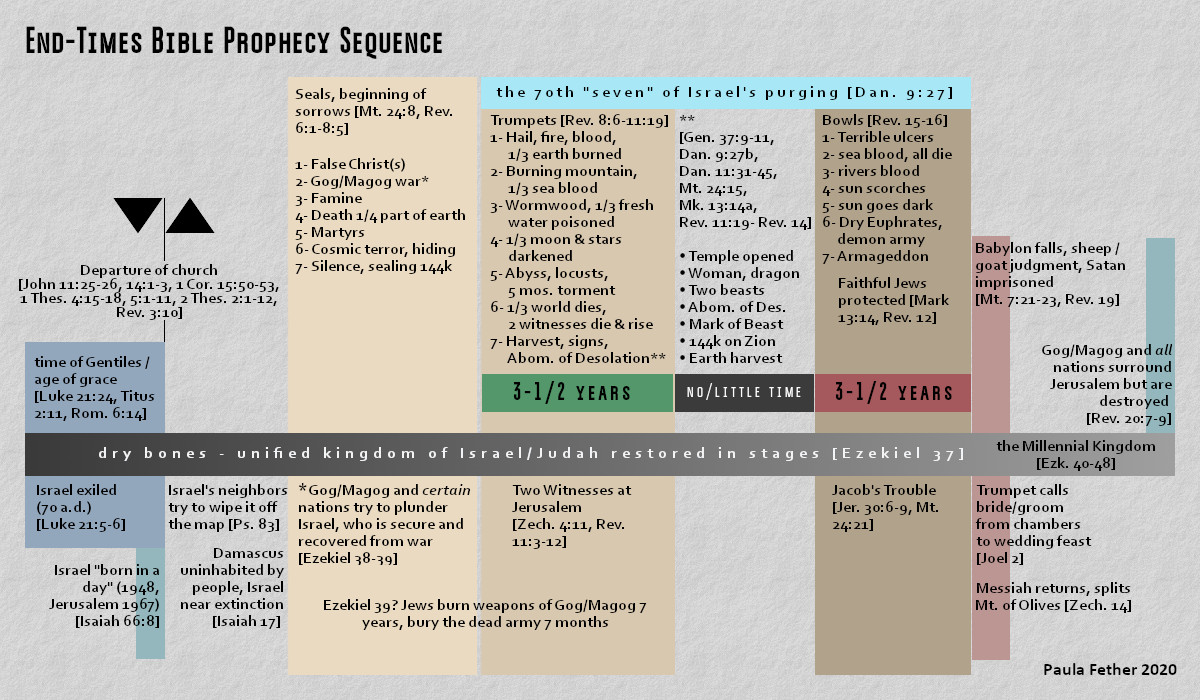 Notice that the people of Israel will use the defeated army’s weapons as fuel for 7 years. Here again, there’s no need to resort to force-fitting modern weapons into this prophecy. If Israel has given up its weapons, due to feeling secure and as a possible part of the covenant mentioned in Dan. 9:27, it would make an easy target for nations with even the most low-tech weaponry. But we’ll only know for sure when we see it fulfilled. The point is that Israel will plunder those who sought to plunder it.
Notice that the people of Israel will use the defeated army’s weapons as fuel for 7 years. Here again, there’s no need to resort to force-fitting modern weapons into this prophecy. If Israel has given up its weapons, due to feeling secure and as a possible part of the covenant mentioned in Dan. 9:27, it would make an easy target for nations with even the most low-tech weaponry. But we’ll only know for sure when we see it fulfilled. The point is that Israel will plunder those who sought to plunder it.
Starting in verse 11 is the aftermath of all those deaths. There will be people employed during that time to go out and mark all the places where a dead body lies, and others will come along and bury them. Since this takes place “on that day”, it remains to be fulfilled, but the question is when. It seems unlikely that such a situation as described here would take place during the second half of the Tribulation, when faithful Jews will have fled the land for the place of safety in the desert. Neither would such a graveyard be likely to exist on the new earth after the Millennium. So by process of elimination we’re left with a either before or during the first half of the Tribulation, or during the first seven years of the Millennium. But we should make note of the fact that the motives and method-of-defeat of Gog are not the same in this passage as in the only other passage about Gog, that being Rev. 20:8.
On the other hand, verse 17 is referenced in Rev. 19:17-18, which takes place at the beginning of the Millennium, and Israel turns to God as a result. Yet on the other other hand, the end of the Tribulation is a very unlikely time for there to be a Magog left to muster an army. We simply don’t know where this event fits, but we know it will be literally and physically fulfilled. And remember that one part of a prophecy can be separated from another by many years. Verse 25 turns to what is undeniably the Millennium by description.
Ezekiel 40-43
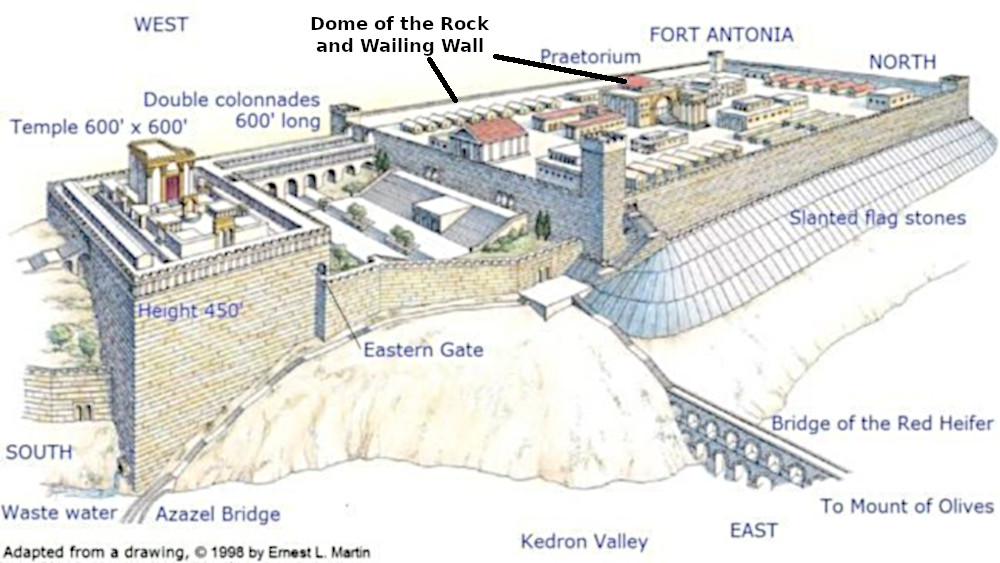 This is a separate, later vision about the Millennial Kingdom and Temple. This is not to be confused with the Tribulation temple, which according to Zech. 14:2 will likely be destroyed when Jerusalem is ransacked during the Bowl judgments. The vision begins with the Millennial Temple, on the spot of Solomon’s Temple, whose location was on the Gihon River and not the present-day Dome of the Rock. There’s an excellent article here, and this is one of the images, to which I’ve added the likely locations of the Dome of the Rock and Wailing Wall.
This is a separate, later vision about the Millennial Kingdom and Temple. This is not to be confused with the Tribulation temple, which according to Zech. 14:2 will likely be destroyed when Jerusalem is ransacked during the Bowl judgments. The vision begins with the Millennial Temple, on the spot of Solomon’s Temple, whose location was on the Gihon River and not the present-day Dome of the Rock. There’s an excellent article here, and this is one of the images, to which I’ve added the likely locations of the Dome of the Rock and Wailing Wall.
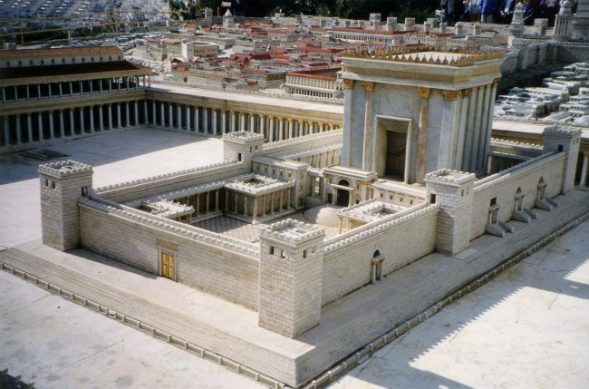 The next image is what the Millennial Temple will probably look like. The precise measurements and layout are given here, and there’s also a drawing in the commentary. This continues into chapters 41 and 42. Ch. 43 is where Ezekiel sees the glory of God again, coming from the east and filling the temple. Then after another reminder of past sins of Israel, it describes the altar itself with just as much attention to detail. But as rules for the sacrifices and rites are described starting in verse 18, beginning with a purification ritual, notice that these are not identical to those under the law of Moses. That system looked forward to the Messiah, while this one will look back as a reminder, especially for Israel. The priesthood of Zadok is connected with the reign of David, whose kingdom this will be.
The next image is what the Millennial Temple will probably look like. The precise measurements and layout are given here, and there’s also a drawing in the commentary. This continues into chapters 41 and 42. Ch. 43 is where Ezekiel sees the glory of God again, coming from the east and filling the temple. Then after another reminder of past sins of Israel, it describes the altar itself with just as much attention to detail. But as rules for the sacrifices and rites are described starting in verse 18, beginning with a purification ritual, notice that these are not identical to those under the law of Moses. That system looked forward to the Messiah, while this one will look back as a reminder, especially for Israel. The priesthood of Zadok is connected with the reign of David, whose kingdom this will be.
Ezekiel 44-48
Ch. 44 begins by explaining that the gate through which God enters the santuary will remain shut forever afterward. Then it turns to another vision of God’s glory filling the temple, and another caution for Israel against ever repeating their violations of it. Then in verse 10 God states that the Levites will no longer be permitted to serve as priests, but instead will be relegated to watching over the gates, which includes managing the day-to-day business of temple activities. The exceptions will be the line of Zadok, as we see in verse 15. Following that are rules given for those priests.
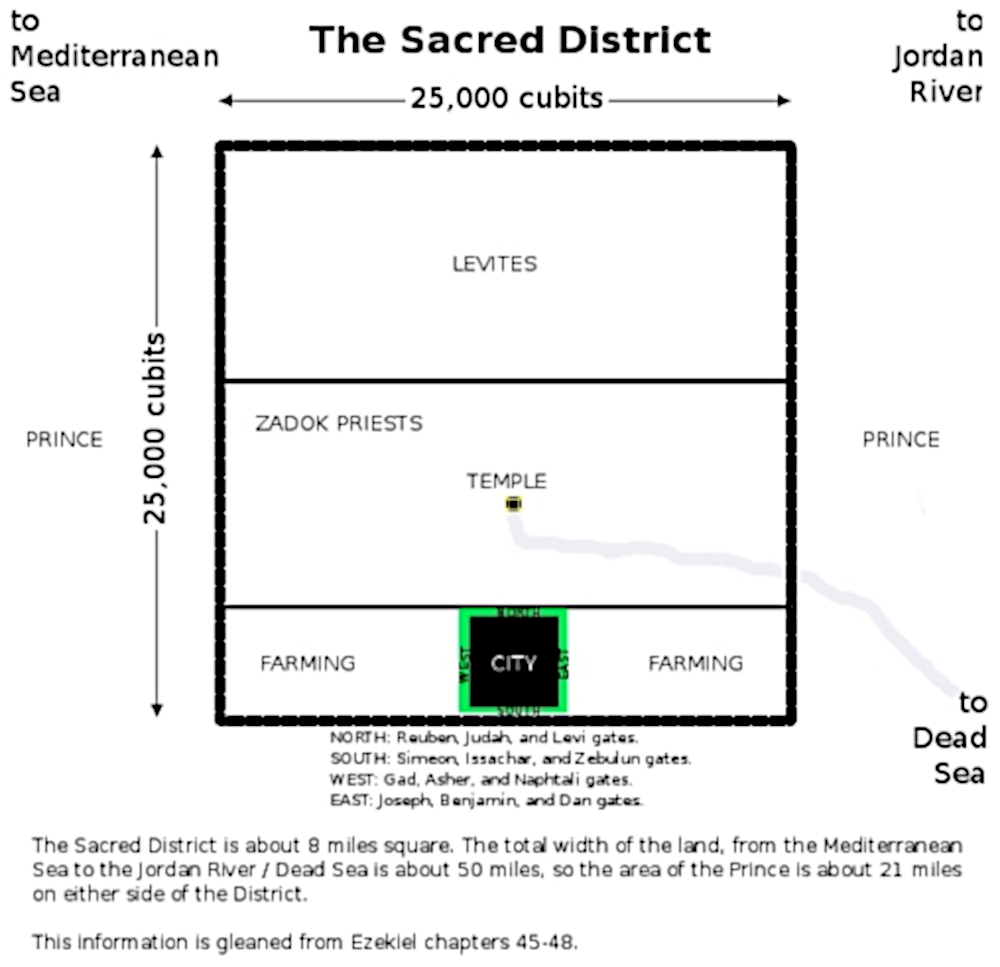 Ch. 45 begins a description of a special plot of land sometimes referred to as The Sacred District. You can see more details about this at this source, which distinguishes the Sacred City in this district from both Jerusalem and the New Jerusalem.
Ch. 45 begins a description of a special plot of land sometimes referred to as The Sacred District. You can see more details about this at this source, which distinguishes the Sacred City in this district from both Jerusalem and the New Jerusalem.
As you can see in this image, the land is divided into places for the Levites, the priests of Zadok, the Temple, farmland, and the Sacred City. On either side of the District is land assigned to “the prince”, who can’t be Jesus since he has to make atonement for his sins and cannot enter through the Lord’s Gate. It would have to be either David or a descendant, though we should keep in mind that the resurrected David will no longer be mortal, while this prince will have children during the Millennium.
Descriptions continue into ch. 46, and then ch. 47 focuses on a strange river of water flowing from under the threshold of the temple toward the east, which is crudely represented in the drawing here. As Ezekiel follows it along, the water becomes deeper and deeper, until it’s too deep and wide to cross.
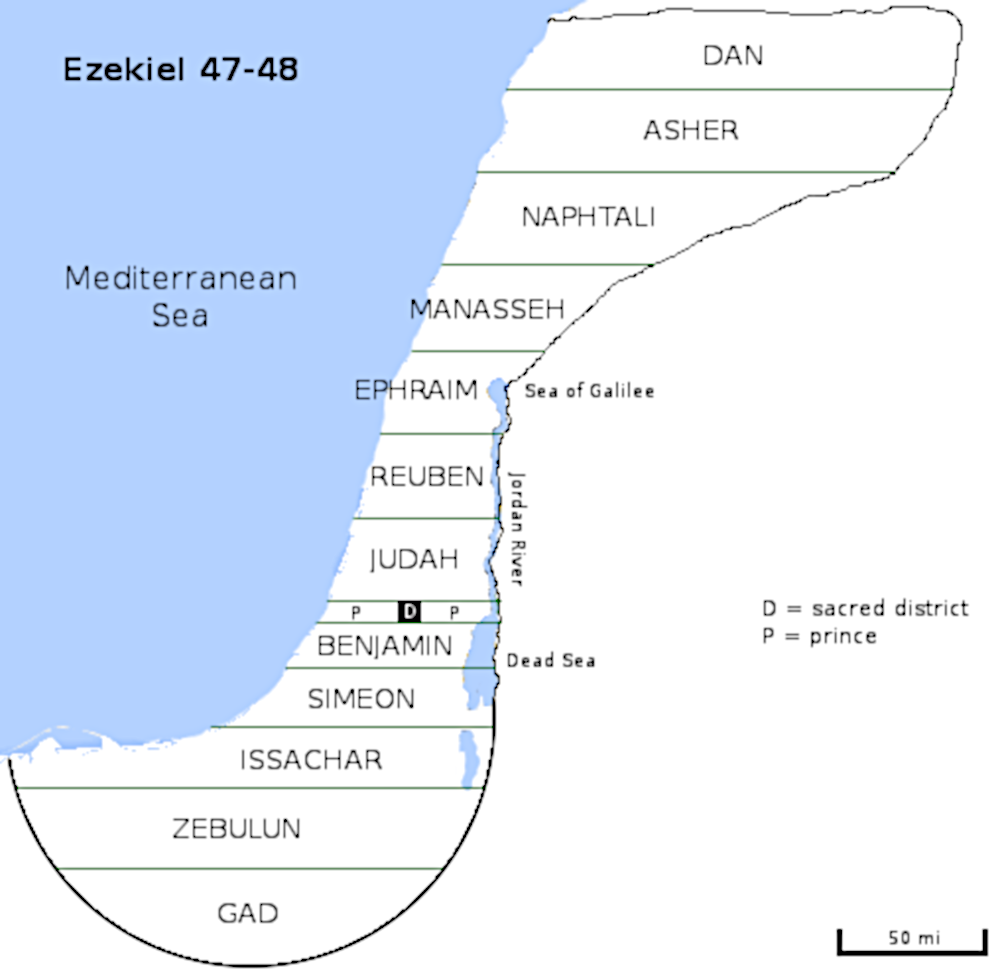 Ezekiel is told that the river empties into the Dead Sea, which becomes “alive” because of its source. Notice what it says about trees on the riverbanks: Their fruit is for food and their leaves for healing, which tells us that Rev. 22:1-2 must refer to the Millennium rather than the new earth, since there will be no temple after the Millennium according to Rev. 21:22.
Ezekiel is told that the river empties into the Dead Sea, which becomes “alive” because of its source. Notice what it says about trees on the riverbanks: Their fruit is for food and their leaves for healing, which tells us that Rev. 22:1-2 must refer to the Millennium rather than the new earth, since there will be no temple after the Millennium according to Rev. 21:22.
As for the rest of the land of Israel, it will be laid out roughly as shown here and in the commentary, according to the boundaries and landmarks as given in the text (though some put the eastern boundary at the Euphrates much farther out). Levi and Joseph are replaced by the two tribes of Manasseh and Ephraim, since Levi has land inside the Sacred District.
The details continue through the end of the book, which makes sense of a lot of things in Revelation that otherwise seem obscure.

